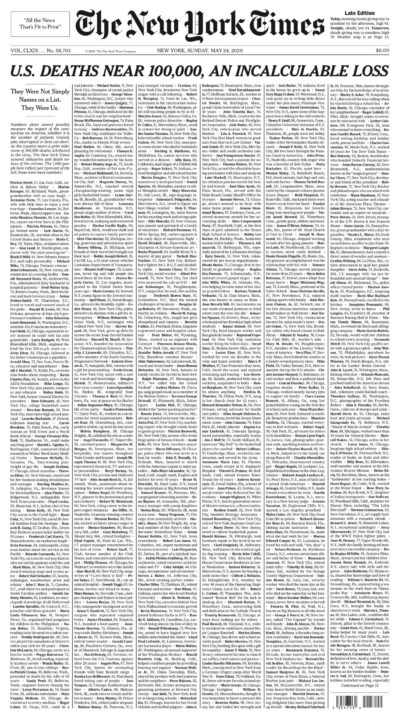On May 23, 2020, (May 24 in print), the New York Times landed a daring and historic front page: A wash of overwhelming gray, which jumped to two more gray pages inside the print paper. To mark the deaths of 100,000 Americans from COVID-19, the Times published the names of 1,000 of them — just 1 percent of the total — each with a spare couple of lines about their lives.
 Spare as those lines were, they were what made the gray pulse with humanity. These were not just names, but people. People who fought in wars and baked pies and led companies and guided classrooms. People who painted and puttered and escaped tyranny to come to the U.S. and raise families with the hope of better futures. Versatile New York Times writer Dan Barry wrote an essay that read like a gift box holding all those precious names; he was supported by information gathered by a team of professionals and gleaned from dozens of news organizations around the country. Writing scholar and coach Roy Peter Clark wrote an analysis for Storyboard and the Poynter Institute about the place and power of the obituary in journalism. Elizabeth Bukey of Roslindale, Massachusetts, commented on the same, in a thank-you letter to the Times, from her work as a minister:
Spare as those lines were, they were what made the gray pulse with humanity. These were not just names, but people. People who fought in wars and baked pies and led companies and guided classrooms. People who painted and puttered and escaped tyranny to come to the U.S. and raise families with the hope of better futures. Versatile New York Times writer Dan Barry wrote an essay that read like a gift box holding all those precious names; he was supported by information gathered by a team of professionals and gleaned from dozens of news organizations around the country. Writing scholar and coach Roy Peter Clark wrote an analysis for Storyboard and the Poynter Institute about the place and power of the obituary in journalism. Elizabeth Bukey of Roslindale, Massachusetts, commented on the same, in a thank-you letter to the Times, from her work as a minister:
And I couldn’t stop thinking about that front page, or returning to it again and again to read a few more of those spare and searing life stories. Somewhere I scratched a list of possible Storyboard assignments about obituaries: How they are used in journalism school to teach young wannabes the basics. How reporting and writing obits can teach some of the most important lessons of accurate, compassionate journalism. How daily news obits seem to have a different place in the U.S. than in international journalism. How newsrooms wrestle with the ethics of obits about less-than-honorable people. How obits have changed in the digital era as families file personal stories of their loved ones on websites. How journalists, late at night after a couple of drinks, burden colleagues with the obligation of writing their obits when the time comes. Even how more and more people are writing their own obits before they die. One of my favorite is by and about Ken Fuson, a darling man and sterling writer who struggled with addiction and self-doubt — and whose journalism was better for admitting it.
All this from a single project published May 24, 2020.
Then, on May 25, 2020, George Floyd died either during or just after being held under the knee of a police officer in Minneapolis, Minnesota. Cities around the world erupted in protests against racial injustice — protests which continue to grow two weeks later. COVID-19, which dominated worldwide news for three months, found itself pushed to the bottom of the page, or aside altogether. That cornucopia of ideas connected to coronavirus deaths suddenly seemed out of sync.
But something you learn in a lifetime in this profession is that good stories never go away — they just wait for their time to come back around. So it is with COVID, sadly. The global death count surpassed 400,000 today; the U.S. death count was reported to be at 113,000. Infections are blooming fast in hotspots around the world. There are warnings of more to come as a result of the hundreds of thousands of people who have chosen that the risk of infection pales in comparison to centuries of racial injustice.
So I returned to my list of obit ideas. And that brought me back to the notion of the personal obit, and what journalists can do to mark the life of the individual when the numbers are about the masses. In my notes was the mention of a Facebook post by my niece, written on May 23 in reaction the New York Times front page. I repeat some of it here, with her full permission:
Her post reminded me of one of the things that impressed me most about the New York Times project: journalists took time and care to capture a life in a spare line or two. It reminded me the "six-word memoir" as a writing challenge and teaching tool. (Can you summarize the story you want to do in six words? Much less a life?) It reminded me of the hundreds of cemeteries I've visited around the world, and how much is told in a name and date — and how much more that makes me want to know about a life lived and now gone but passed forward in memories. It reminded me of how important it is for journalists, charged with writing obits as professionals, to divine (report and then choose) the essence of someone's life. It reminded me what we have to learn — and teach — to earn the right to do that.
And it has made me think about what I would write, or want written, in a few spare lines about my own.
 Spare as those lines were, they were what made the gray pulse with humanity. These were not just names, but people. People who fought in wars and baked pies and led companies and guided classrooms. People who painted and puttered and escaped tyranny to come to the U.S. and raise families with the hope of better futures. Versatile New York Times writer Dan Barry wrote an essay that read like a gift box holding all those precious names; he was supported by information gathered by a team of professionals and gleaned from dozens of news organizations around the country. Writing scholar and coach Roy Peter Clark wrote an analysis for Storyboard and the Poynter Institute about the place and power of the obituary in journalism. Elizabeth Bukey of Roslindale, Massachusetts, commented on the same, in a thank-you letter to the Times, from her work as a minister:
Spare as those lines were, they were what made the gray pulse with humanity. These were not just names, but people. People who fought in wars and baked pies and led companies and guided classrooms. People who painted and puttered and escaped tyranny to come to the U.S. and raise families with the hope of better futures. Versatile New York Times writer Dan Barry wrote an essay that read like a gift box holding all those precious names; he was supported by information gathered by a team of professionals and gleaned from dozens of news organizations around the country. Writing scholar and coach Roy Peter Clark wrote an analysis for Storyboard and the Poynter Institute about the place and power of the obituary in journalism. Elizabeth Bukey of Roslindale, Massachusetts, commented on the same, in a thank-you letter to the Times, from her work as a minister:… memorializing someone is about much more than remembering the outlines of a person’s life. It’s about making what seems unreal — death of our loved one — more real, more concrete. It’s about building a container for our grief. It’s about retelling the story of how the person who died has shaped us.
And I couldn’t stop thinking about that front page, or returning to it again and again to read a few more of those spare and searing life stories. Somewhere I scratched a list of possible Storyboard assignments about obituaries: How they are used in journalism school to teach young wannabes the basics. How reporting and writing obits can teach some of the most important lessons of accurate, compassionate journalism. How daily news obits seem to have a different place in the U.S. than in international journalism. How newsrooms wrestle with the ethics of obits about less-than-honorable people. How obits have changed in the digital era as families file personal stories of their loved ones on websites. How journalists, late at night after a couple of drinks, burden colleagues with the obligation of writing their obits when the time comes. Even how more and more people are writing their own obits before they die. One of my favorite is by and about Ken Fuson, a darling man and sterling writer who struggled with addiction and self-doubt — and whose journalism was better for admitting it.
All this from a single project published May 24, 2020.
Moving beyond the news to the stories that continue
Then, on May 25, 2020, George Floyd died either during or just after being held under the knee of a police officer in Minneapolis, Minnesota. Cities around the world erupted in protests against racial injustice — protests which continue to grow two weeks later. COVID-19, which dominated worldwide news for three months, found itself pushed to the bottom of the page, or aside altogether. That cornucopia of ideas connected to coronavirus deaths suddenly seemed out of sync.
But something you learn in a lifetime in this profession is that good stories never go away — they just wait for their time to come back around. So it is with COVID, sadly. The global death count surpassed 400,000 today; the U.S. death count was reported to be at 113,000. Infections are blooming fast in hotspots around the world. There are warnings of more to come as a result of the hundreds of thousands of people who have chosen that the risk of infection pales in comparison to centuries of racial injustice.
So I returned to my list of obit ideas. And that brought me back to the notion of the personal obit, and what journalists can do to mark the life of the individual when the numbers are about the masses. In my notes was the mention of a Facebook post by my niece, written on May 23 in reaction the New York Times front page. I repeat some of it here, with her full permission:
What would be written about me if I were to die during this pandemic?
Tracy Banaszynski, 46, Kenmore, Washington, loved salmon with a passion that no family member could trace. Or Tracy Banaszynski, 46, Kenmore, Washington, let her son turn their strawberry patch into a dig site where he buried a glass jar filled with Reese Pieces for safe storage during the pandemic. Or Tracy Banaszynski, 46, Kenmore, Washington, wanted so badly to connect with people at a heart level and was often unsure of how to bridge the distance imposed by the illusion of separation. Or Tracy Banaszynski, 46, Kenmore, Washington, occasionally thought it might be better to be a tree.
What would be written about someone you love?
Her post reminded me of one of the things that impressed me most about the New York Times project: journalists took time and care to capture a life in a spare line or two. It reminded me the "six-word memoir" as a writing challenge and teaching tool. (Can you summarize the story you want to do in six words? Much less a life?) It reminded me of the hundreds of cemeteries I've visited around the world, and how much is told in a name and date — and how much more that makes me want to know about a life lived and now gone but passed forward in memories. It reminded me of how important it is for journalists, charged with writing obits as professionals, to divine (report and then choose) the essence of someone's life. It reminded me what we have to learn — and teach — to earn the right to do that.
And it has made me think about what I would write, or want written, in a few spare lines about my own.



